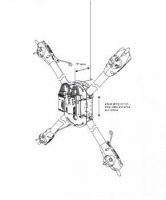In the NAZA Lite mounting section (page 12 of the pdf manual) you have to input the x, y and z coordinates of the GPS antenna of the flight-ready multirotor. And there is a Notice that "You must re-configure if the ALL-UP-WEIGHT had been changed on your multi-rotor". Both items understood.
But in real-life, you're not always going to be flying with the camera (especially in the early testing phases) and you may be flying with batteries of different weights (higher or lower capacities or cell counts), so the all-up weight will change. HOW SENSITIVE is the GPS to weight change? Especially, I imagine, with changes in the "z" coordinate value? With a "properly balanced 'copter" changes in payload or battery weight will cause the value of "z" to change-- increase that weight, and the (absolute) value of "z" will increase (ie, -2 to -3), and vice versa with a decrease in weight. (depending on where the GPS is located, "x" and "y" may change, too, but let's ignore that for the time being)
Would it work to "set" the GPS z-value using a maximum battery and payload weight (assuming a light one-axis camera mount and a light point-and-shoot camera) even though you may fly with lighter batteries or no camera? Re-configuring the system for "minor" changes in weight (of a few ounces) could be a PITA.
I'm going to assume that the would apply only to flight modes that use GPS and not the simple "Atti" mode. And also assuming that the basic x-y balance is good.
Convoluted question... waiting for snow.
--Bill
But in real-life, you're not always going to be flying with the camera (especially in the early testing phases) and you may be flying with batteries of different weights (higher or lower capacities or cell counts), so the all-up weight will change. HOW SENSITIVE is the GPS to weight change? Especially, I imagine, with changes in the "z" coordinate value? With a "properly balanced 'copter" changes in payload or battery weight will cause the value of "z" to change-- increase that weight, and the (absolute) value of "z" will increase (ie, -2 to -3), and vice versa with a decrease in weight. (depending on where the GPS is located, "x" and "y" may change, too, but let's ignore that for the time being)
Would it work to "set" the GPS z-value using a maximum battery and payload weight (assuming a light one-axis camera mount and a light point-and-shoot camera) even though you may fly with lighter batteries or no camera? Re-configuring the system for "minor" changes in weight (of a few ounces) could be a PITA.
I'm going to assume that the would apply only to flight modes that use GPS and not the simple "Atti" mode. And also assuming that the basic x-y balance is good.
Convoluted question... waiting for snow.
--Bill

